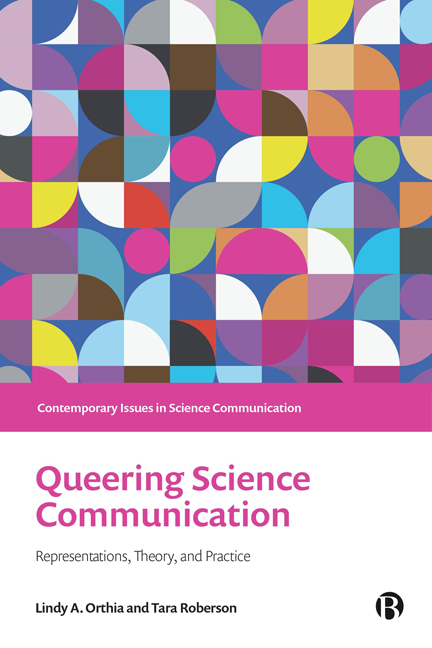Book contents
- Frontmatter
- Contents
- Series Editor Preface
- Notes on Contributors
- Acknowledgements
- Terminology and Sensitive Content in This Book
- Introduction
- PART I Negotiating Queer Identities with Science, Technology, and Medicine
- PART II Representations of Queerness in Public Science Communication
- PART III Queer People in Science Communication Communities
- PART IV Queering Institutional Science Communication Agendas
- Conclusions
- Index
2 - The Question of Queer Complexity: Science Communication and Queer Activism
Published online by Cambridge University Press: 18 January 2024
- Frontmatter
- Contents
- Series Editor Preface
- Notes on Contributors
- Acknowledgements
- Terminology and Sensitive Content in This Book
- Introduction
- PART I Negotiating Queer Identities with Science, Technology, and Medicine
- PART II Representations of Queerness in Public Science Communication
- PART III Queer People in Science Communication Communities
- PART IV Queering Institutional Science Communication Agendas
- Conclusions
- Index
Summary
Content warning: this chapter discusses an abusive 20th century scientific experiment that involved children and also suicide.
Political activism is an important domain in which science communication is used to support, or oppose, social change. In the recent past, queer activism has employed science-related arguments with varying results. Like many of the topics covered in this book, the academic literature on science communication in queer activism is sparse to non-existent. Accordingly, this chapter offers a retrospective examination of some of the science communication used by queer activists in the West, identified by examining historical newspaper articles, the archives of independent queer newspapers, audio-visual compilations of queer activism curated by libraries and museums, and the extant relevant academic publications. It is hoped that this foundational research will provide a starting point for future researchers to refine and fill the gaps. A further aim is to support and improve queer activism in the future by scrutinizing the role of science communication in queer activism in the past.
Nearly 75 years ago, in 1952, the first Diagnostic and Statistical Manual (DSM-I) of the American Psychiatric Association (APA) declared anything that deviated from cis-heteronormativity was a form of pathological psychosis (APA, 1952). This included a variety of non-heterosexual attractions and activities, as explained in more detail later. The inclusion of non-cis-heteronormality as a psychotic illness persisted across different editions, through direct and indirect references until at least 1987. Activism helped direct a long process of change until the APA board of trustees elected to remove the definition of homosexuality as a form of psychosis from the DSM (Drescher and Merlino, 2007). In 1990, the World Health Organization followed suit by removing homosexuality from the International Classification of Diseases (ICD-10). It took even longer for transgender-related classifications to be removed or amended in the DSM and the ICD, again under the influence of activist pressure. In 2013 the DSM-5 dropped ‘gender identity disorder’ as a diagnosis but replaced it with ‘gender dysphoria’, which many trans activists still consider problematic (Whalen, n.d.), to the point that the Danish government officially removed the ‘mentally ill’ classification of trans people in 2017, overriding the DSM's classification in Denmark (Russo, 2017).
- Type
- Chapter
- Information
- Queering Science CommunicationRepresentations, Theory, and Practice, pp. 32 - 47Publisher: Bristol University PressPrint publication year: 2023



